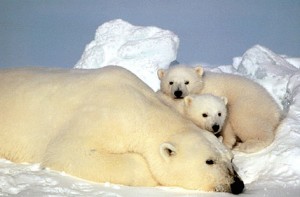 The United States declared the polar bear a threatened species yesterday; saying the dramatic reduction in sea ice caused by global warming has put it in imminent danger of extinction.
The United States declared the polar bear a threatened species yesterday; saying the dramatic reduction in sea ice caused by global warming has put it in imminent danger of extinction.
Although this was the first time the US Endangered Species Act was used to protect a species threatened by climate change, the bears will only be legally protected from the direct effects of hunting, and some other activities, because of limits imposed by the Interior Department. It invoked a seldom used loophole to make it easier for the oil and gas industry to actually expand activities that already threaten the bears and their habitat.
The Interior Secretary, Dirk Kempthorne, who spent much of his political life opposing the Endangered Species Act, said it would be “inappropriate” to use the polar bear listing “to regulate global climate change”.
Faced with overwhelming scientific evidence that already rapid loss of sea ice is accelerating, Mr Kempthorne said and he no choice but to declare the species threatened.
“Sea ice is vital to polar bears’ survival,” he said. “This has been a difficult decision. But in light of the scientific record, and the restraints of the inflexible law that guides me,” he had made “the only decision I can make.” But he then added “This listing will not stop global climate change or prevent any sea ice from melting.”
So its now worth the paper its written on…. Another Bush Administration farce..

Why Do We Care If Polar Bears Become Extinct?
This is not any sort of revelation: Polar bears declared a threatened species , but it does raise the question: Why do we care? By some estimates, 90% of all species that once existed are now extinct and new species are always taking their place. For the species that’s going to become extinct, for whatever reason, extinction is the end of it. However, for the species that remain, is the extinction of another species good or bad? When Europeans first colonized North America, there was an estimated five (5) billion Passenger Pigeons alive and well in North America. In 1914, they were extinct. Passenger Pigeons didn’t live in little groups, but huge flocks that required extraordinary quantities of hardwood forests for them to feed, breed and survive. Deforestation to build homes, create farmland and over hunting for cheap food decimated their population. The westward drive to grow the United States in the 1800s and early 1900s was incompatible with the needs of the Passenger Pigeon and they literally could not survive in the new North America being carved out by the U.S. economy. The interesting thing about the Passenger Pigeon was the impact its extinction had on another species—man. That impact was essentially none. Man continued to find ways to feed himself through agriculture and other technologies and the United States and its citizens continued to prosper from the early 20th century till today. Whether or not Polar Bears become extinct because of Global Climate Change or other reasons, we need to address the larger question of: Do we care and why? One of the ways a nation, its citizens and the global community can answer that question is addressed by John A. Warden III in Thinking Strategically About Global Climate Change. He asks some interesting biodiversity questions in his post to include How Many Species Is the Right Number and Which Ones?
Let\’s save endangered species and make world green